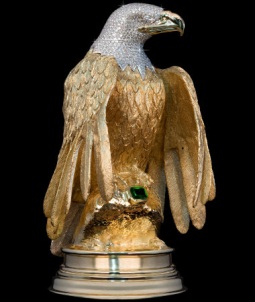Sunken Treasure and Stolen Jewels: Emeralds Through History
by Kat Paulick
On September 4, 1622, a convoy of 28 Spanish ships departed Havana, stuffed to the brim with treasure. Hundreds of millions of dollars worth of silver, gold, emeralds, and pearls plundered from across Central and South America filled the holds, but many of the sailors bound for home with these riches would never reach the Spanish shores. The day after their departure, a hurricane struck the fleet off the coast of Florida. Nuestra Señora de Atocha, carrying a 25.87-carat emerald known as the Atocha Star, was one of eight ships claimed by the storm, which killed hundreds and left priceless treasure scattered among the wreckage at the bottom of the Caribbean.
The Atocha Star hailed from Colombia, one of the world’s largest producers of emeralds. The conditions required to create these gems are relatively rare: beryllium, oxygen, silicon, and aluminum, elements which occur at different depths of the earth’s crust, meet in hydrothermal veins. With the right temperature and pressure, these elements can combine and form the mineral beryl, of which emerald is a type. When pure, beryl is colorless – the lush green color of an emerald results from impurities (the elements chromium and vanadium). Emeralds can also form in pegmatite deposits, where they are created by the cooling of magma and the necessary elements remaining in the fluids.
Because of the rarity of conditions, most emeralds hail from just a handful of locations: Colombia, Zambia, and Brazil, with smaller mines existing in Pakistan, Russia, Australia, the United States, and Afghanistan. The earliest known mines were in Egypt, dating back to 330 BC. The gem was favored by Cleopatra, who had it set into adornments and even had her own mines.
Ancient cultures revered the stone not just for its beauty but for its metaphysical properties. Emeralds were believed to reveal the truth of one’s speech, increase eloquence, and even allow a person to see into the future. They were said to bring good fortune and health and used to aid in healing cholera, malaria, and inflammation of the eyes – lapidaries still gaze into emeralds to relieve eye strain. They are considered regenerative to both the physical body and the emotions and are symbolic of love, success, and fertility. The emerald is the birthstone of May and represents the new life and beginnings of spring.
The emeralds brought home by the Spanish conquistadors exploded the stone’s popularity among European and Asian royalty, and many Colombian gems were set into now infamous pieces of jewelry. The Colombian Chalk Emerald now sits at the Smithsonian, but the 37.8 carat stone was once the centerpiece of a diamond necklace owned by Indian Maharani Sita Devi.

One of the most famous emerald pieces, the Vladimir tiara, originally featured no emeralds at all. Commissioned by Grand Duchess Vladimir of the Russian Romanovs, the crown was made of diamonds and featured hanging pearl pendants. When the Russian Revolution put her family in peril, the duchess fled to a hideout in Kislovodsk, leaving the tiara and her other jewels in a safe at the palace.
They were eventually smuggled out by a family friend and passed to the duchess’s daughter before being sold to Queen Mary, grandmother of Queen Elizabeth II. Queen Mary replaced the tiara’s hanging pearls with emeralds from her own collection, and the stunning piece now sits on display at Buckingham Palace. More recently, British tabloids reported that Megan Markle had hoped to wear the crown for her wedding to Prince Harry, but was refused.
Considering the desirability of these gems, it’s no surprise that many attempts were made to recover the sunken Atocha Star. Mel and Deo Fisher searched for 16 years before literally and figuratively striking gold in 1985. They discovered a 13,500-carat pile of emeralds they dubbed “Emerald City” and recovered the Star along with $400 million in treasure. The stone was eventually mounted onto The Golden Eagle, an 18-pound solid gold and diamond-encrusted eagle statue, and displayed at the Art Vancouver exhibit. However, the slippery gem’s journey didn’t end there: It was stolen after only four days, and its whereabouts are still unknown.
If you’re lucky enough to own an emerald, avoid cleaning it with heat or harsh chemical cleansers. This precious stone is best cared for with mild soapy water (but do not soak it) and a soft cloth. Store it individually to prevent scratches, and enjoy its beauty (and possibly good health and fortune) for years to come.
Shop all of The Gemmary’s emerald jewelry below!









Leave a Reply
Want to join the discussion?Feel free to contribute!